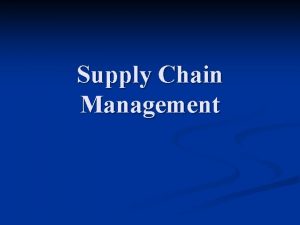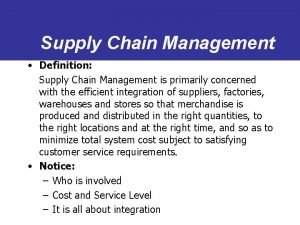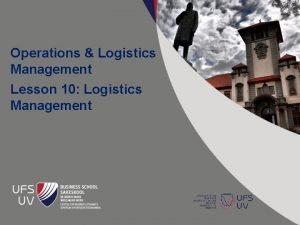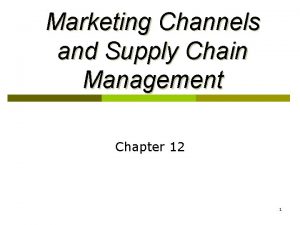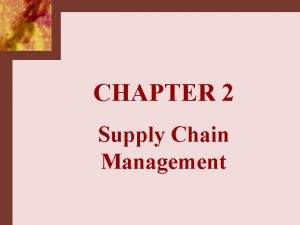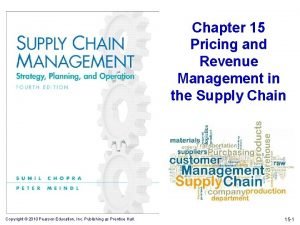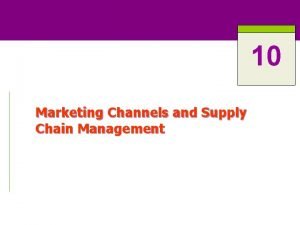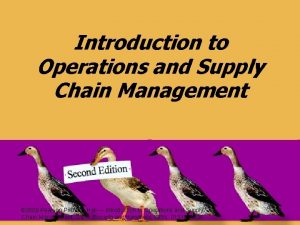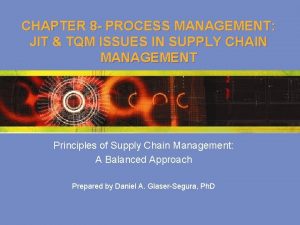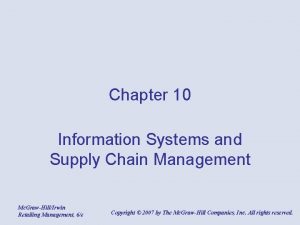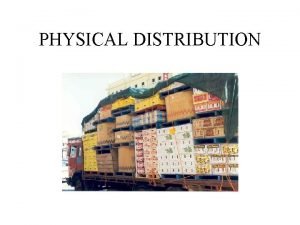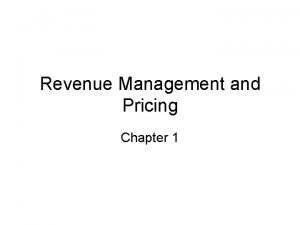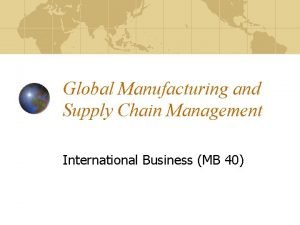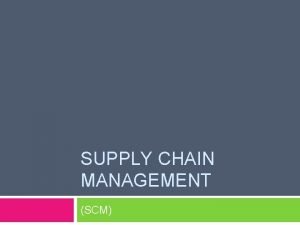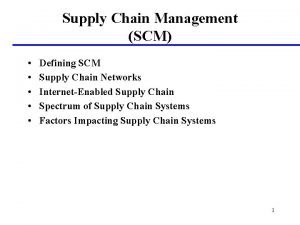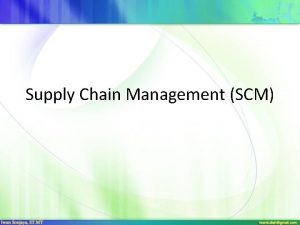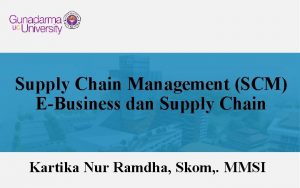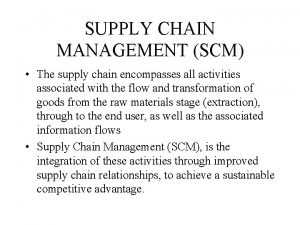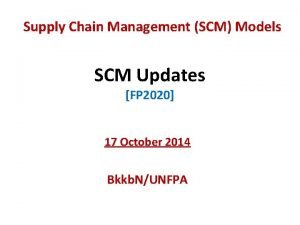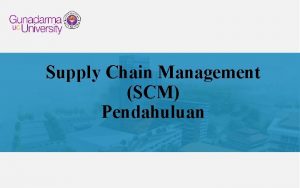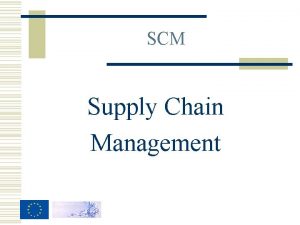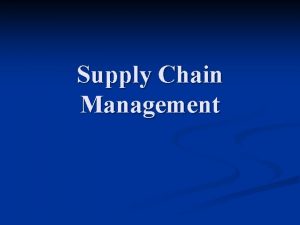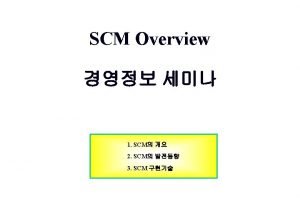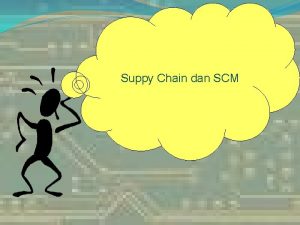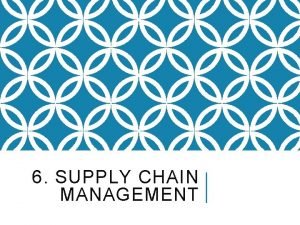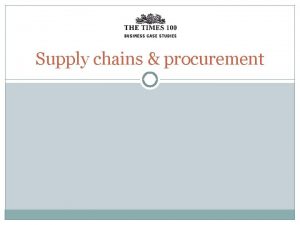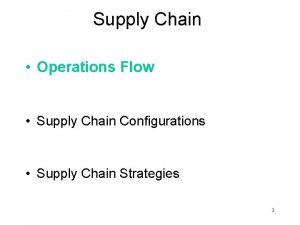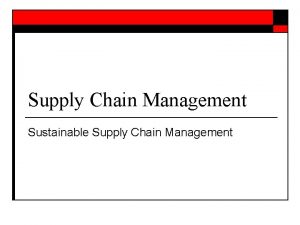Supply Chain Management SCM concerns the coordination and






















- Slides: 22

Supply Chain Management (SCM) concerns the coordination and optimization of all supply, manufacturing, distribution and logistics activities from raw materials to finished goods to the customer. Raw Materials Suppliers Component Manufacturer Systems Integrator Assembler Integrated Manufacturer Logistics Provider Distributor Customer Session 25 Operations Management 1

Supply Chain Coordination Suppliers Manufacturers Goods Flow Session 25 Wholesale Distributors Information Flow Operations Management Retailers Customers Cash Flow 2

SCM Goals w Maximize profits of all supply chain partners w How to do it? n Get the right product, in the right quantity, to the right customer at the right time with minimum cost, proper documentation and financial reconciliation w Difficulty: Each partner has its own goal w What are the objectives? n What is channel coordination? n Why are channels not coordinated? n How can we coordinate channels? Session 25 Operations Management 3

Channel Coordination: Example A single publisher sells a book to a retailer. Notations Production cost of the supplier = w = 9 Revenue form sale to consumer =p = 39 Carrying cost = h = 1 Supplier sale price to the retailer = c = 19 Salvage value of the product = v= 0. w Cu= 39 -19=20 w Co=19+1=20 SL*= P(D≤Q) ≥ Cu/(Cu+Co) SL*= P(D≤Q) ≥ 20/(20+20) = 0. 5 Session 25 Operations Management 4

Question is… w Which supply chain is better? n Decentralized decision making n Centralized decision making Session 25 Operations Management 5

Decentralized Decision Making How much does the retailer order? P(D≤ Q)=Cu/(Cu+Co) = 20/(20+20)= 0. 5 Demand Probability 1000 2000 3000 4000 0. 2 0. 3 0. 25 1000 P=. 2 2000 P=. 5 ≥ 0. 5 Stop Order 2000 Session 25 Operations Management 6

Decentralized w = 9, p = 39, h = 1, c = 19, v=0. What is the profit of the wholesaler if the retailer orders 2000 units Profit-Wholeseler = 2000(19 -9) = 20000 What is the profit of the retailer if the retailer orders 2000 units How many units is sold if the retailer order 2000 units? Demand Probability 1000 2000 3000 4000 0. 2 0. 3 0. 25 1000 with 20%, 2000 with 80% Average sale =. 2(1000)+. 8(2000)= 1800 Average Salvage = 2000 -1800 = 200 1800(39 -19)-200(19+1)= 32000 Session 25 Operations Management 20000 Wholesaler 32000 Retailer 52000 Total Profit 7

Centralized Decision Making w Suppose you own both bookstore and the publisher. What is the optimal number of books to be printed by the publisher and offered by the retailing department? w w = 9, p = 39, h = 1, c = 19, v=0. Cu= 39 -9= 20 Co= 9+1= 10 1000 P=. 2 2000 P=. 5 Demand 3000 P=. 75 Probability 1000 2000 3000 4000 0. 2 0. 3 0. 25 3000 P=. 75 ≥ 0. 75 Stop Order 3000 Session 25 Operations Management 8

Centralized: Sell to Retailer at Cost w = 9, p = 39, h = 1, c = 19, v=0. What is the profit of the wholesaler if the retailer orders 3000 units How many units is sold if the retailer order 3000 units? Demand Probability 1000 2000 3000 4000 0. 2 0. 3 0. 25 1000 with 20%, 2000 with 30%, 3000 with 50% Average sale =. 2(1000)+. 3(2000)+. 5(3000)= 2300 Average Salvage = 3000 -2300 = 700 2300(39 -9)-700(9+1)= 62000 Session 25 Operations Management 9

Question w Notice: The profit in the integrated company is $62, 000 w The profit in the disintegrated company is only $52, 000 w Why are they leaving some money on the table? Double marginalization w What can be done to increase: n The channel profit n The publisher profit n The retailer profit n Recall that there is $10, 000 on the table. Session 25 Operations Management 10

Channel Coordination: Solutions w Type of channel coordination solutions n Buy back n Revenue Sharing n Vendor Managed Inventory (VMI) n Consignment n Options Session 25 Operations Management 11

Double Marginalization: The Solution w Suppose the publisher is willing to purchase back all the excess inventory. In return for this service, he might change the wholesale price w Example: l Production cost (c) = 9 l Revenue (p) = 39 l Holding cost (h) = 1 l Wholesale price (w) = 12 l Buy back price = 4 w What is the retailer service level? l F(T) = Cu= (39 – 12) =27 , Co = 12 -4+1 = 9 = 27/36 = 0. 75 l Exactly the same as the integrated system Session 25 Operations Management 12

w Why is the profit the same? w Has the problem been solved? Session 25 Operations Management 13

Review w Previously: n Profit publisher: $20, 000 n Profit retailer: $32, 000 w System with buy back n Profit publisher: $6, 200 n Profit retailer: $55, 800 w Do you think implementing the buy back system is feasible? Session 25 Operations Management 14

Double Marginalization: The Solution w We must ensure that both publisher and retailer benefit n n Session 25 How can we do that? (p – w) / (p + h – v) = 0. 75 (39 – w)/(39+1 – v) = 0. 75 39 – w = 30 – 0. 75 v 9 + 0. 75 v = w All pairs (w, v) that satisfy the above equation will coordinate the channel. When the channel is coordinated the retailer will purchase 3000 units. Operations Management 15

Double Marginalization: The solution w For some pairs (w, b), both players will benefit from coordination: n When w = 21 then v = 16 n The service level is: (39– 21)/(39+1– 16) = 18/24=0. 75 n Publisher profit = 3000 * (21 – 9) – 16*{0. 2*2000+0. 3*1000} = 36000 – 10200 = $25, 800 n Retailer profit = $36, 200 n Both players gained by the buyback arrangement Session 25 Operations Management 16

Vertical Integration No Integration Raw Materials Intermediate Manufacturing Assembly Upstream Integration Downstream Integration Raw Materials Intermediate Manufacturing Assembly Distribution End Customer Session 25 Distribution End Customer Operations Management 17

Benetton w Article Reading: "Back to the Future: Benetton Transforms it’s Global network" MIT Sloan management Review, Fall 2001. w Factors contributing to success n Delayed dyeing n Network organization for manufacturing n Network organization for distribution w Benetton’s strategy in supply chain management n Product design (customized by region) n Supply and production (strong upstream vertical integration) n Retail network (mixed downstream vertical integration) w Diversifying into sports Session 25 Operations Management 18

Vertical Integration w To decide whether to vertically integrate, consider: n n n Session 25 Cost: Cost of market transactions between firms vs. cost of administering the same activities internally within a single firm Control: Impact of asset control, which can impact barriers to entry and which can assure cooperation of key value-adding players. Coordination/Information Sharing Operations Management 19

Vertical Integration: Drawbacks w Capacity balancing issues n For example, the firm may need to build excess upstream capacity to ensure that its downstream operations have sufficient supply under all demand conditions. w Potentially higher costs n n Due to low efficiencies resulting from lack of supplier competition. Economy of scale/risking pooling from outsourcing Session 25 Operations Management 20

Factors against Vertical Integration w The vertically adjacent activities are in very different types of industries. For example, manufacturing is very different from retailing. w The addition of the new activity places the firm in competition with another player with which it needs to cooperate. The firm then may be viewed as a competitor rather than a partner. Session 25 Operations Management 21

Alternatives to Vertical Integration w Long-term explicit contracts w Franchise agreements w Joint ventures w Co-location of facilities w Implicit contracts (relying on firms' reputation) Session 25 Operations Management 22
 Total quality management ppt
Total quality management ppt Matching supply with demand
Matching supply with demand Value chain and supply chain difference
Value chain and supply chain difference Crm in logistics and supply chain management
Crm in logistics and supply chain management Correct sequence in supply chain
Correct sequence in supply chain M(ab)3 isomers
M(ab)3 isomers Food chain sequence
Food chain sequence Supply chain management explanation
Supply chain management explanation Logistics management introduction
Logistics management introduction Conventional marketing channel
Conventional marketing channel Marketing channels and supply chain management
Marketing channels and supply chain management Total cost concept in supply chain management
Total cost concept in supply chain management Role of pricing and revenue management in a supply chain
Role of pricing and revenue management in a supply chain Role of pricing and revenue management in a supply chain
Role of pricing and revenue management in a supply chain Supply chain management and marketing channels
Supply chain management and marketing channels Ford mp&l
Ford mp&l Introduction to operations and supply chain management
Introduction to operations and supply chain management Tqm supply chain
Tqm supply chain Single channel distribution
Single channel distribution Information system and supply chain management in retailing
Information system and supply chain management in retailing Components of physical distribution
Components of physical distribution Revenue management and pricing
Revenue management and pricing Global manufacturing and supply chain management
Global manufacturing and supply chain management




